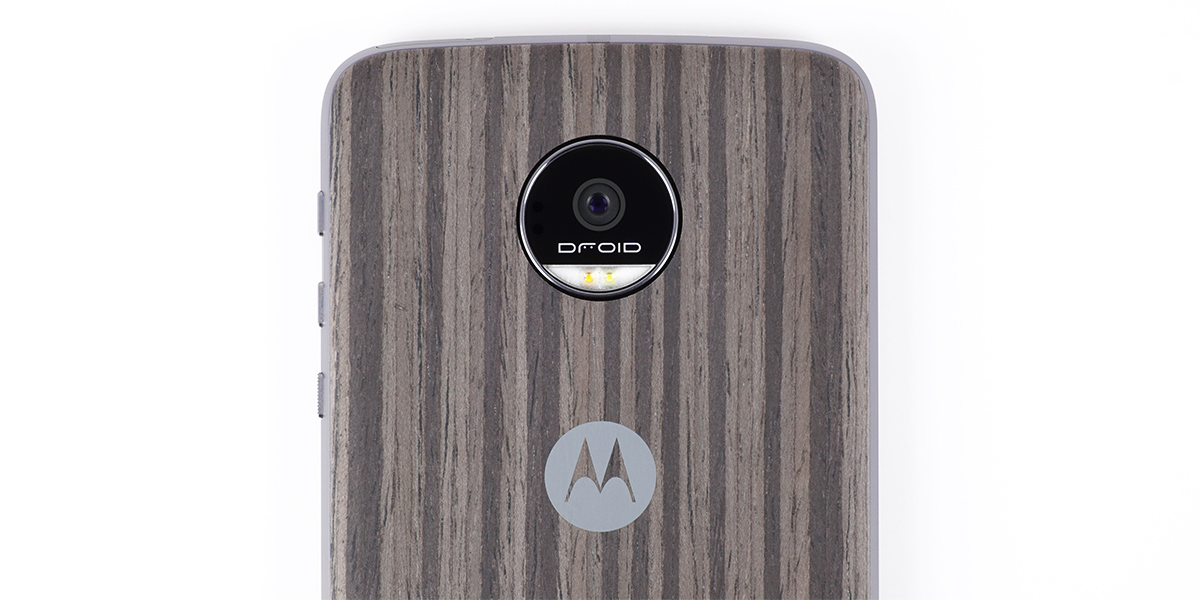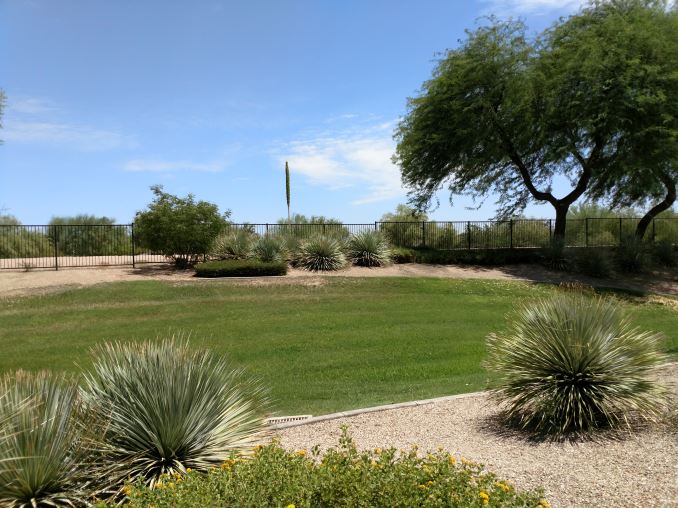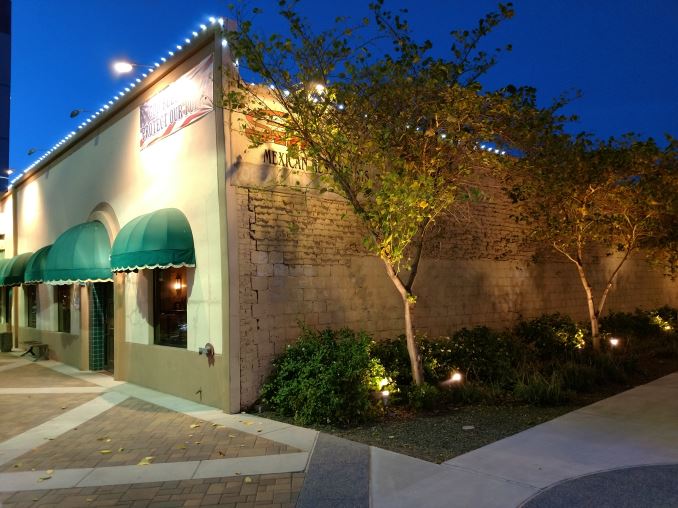The Motorola Moto Z & Moto Z Force (Droid Editions) Review
by Matt Humrick on July 28, 2016 8:00 AM ESTCamera Hardware
The Moto Z Droid comes with a 13MP Sony IMX214 Exmor RS rear camera sensor. This 1/3.06" format CMOS sensor with 1.12µm pixels is backside-illuminated and uses a stacked die. Images are captured with a 4:3 aspect ratio at its native resolution.
The Moto Z Force Droid increases resolution to 21MP by using Sony’s IMX338 Exmor RS sensor for its rear camera. This is also a backside-illuminated CMOS sensor with a stacked die and 1.12µm pixels, but adds deep trench isolation (DTI) technology to reduce electrical crosstalk and improve color fidelity by placing physical barriers between each pixel. The larger 1/2.4" format sensor also uses a 4:3 aspect ratio.
| Camera Architecture | ||
| Moto Z Droid | Moto Z Force Droid | |
| Front Camera: Resolution | 5MP | 5MP |
| Front Camera: Sensor | OmniVision OV5693 (1.4µm, 1/4") |
OmniVision OV5693 (1.4µm, 1/4") |
| Front Camera: Focal Length | 2.45mm (23mm equivalent) | 2.45mm (23mm equivalent) |
| Front Camera: Aperture | f/2.2 | f/2.2 |
| Rear Camera: Resolution | 13MP | 21MP |
| Rear Camera: Sensor | Sony IMX214 Exmor RS (1.12µm, 1/3.06") |
Sony IMX338 Exmor RS (1.12µm, 1/2.4") |
| Rear Camera: Focal Length | 3.68mm (27mm equivalent) | 4.51mm (26mm equivalent) |
| Rear Camera: Aperture | f/1.8 | f/1.8 |
Both rear cameras have a dual-color LED flash to improve color accuracy and optical image stabilization (OIS) to reduce motion blur from shaky hands, which is particularly important for longer exposures in low-light conditions.
The Moto Z Droid uses a hybrid autofocus (AF) system that combines laser AF and contrast AF. The laser AF system uses an infrared laser and its own light sensor to make time-of-flight calculations to quickly determine focus distance in low-light conditions. The laser has a limited range, however, and can be overpowered by environmental sources. In our experience, laser AF is fast when it works, but the slower contrast AF method still ends up doing most of the work.
To overcome these limitations, the Moto Z Force Droid uses a more sophisticated hybrid autofocus system that combines laser and contrast AF with phase detect AF (PDAF), which works well at longer distances and in good lighting. Because their strengths are complementary, using laser AF and PDAF can provide faster, more accurate focusing over a broader range of conditions.
Both Moto Z Droids place a large-aperture lens in front of the rear camera sensor to capture more light, but because of the difference in focal length, the Moto Z Force Droid’s aperture area is 50% larger than its sibling’s, putting it on par with the HTC 10, Galaxy S7, and LG G5, and giving it a 15% advantage over the Moto X Pure Edition and Nexus 6P. The Moto Z Droid’s aperture area is smaller than all of these phones, but is still 17% larger than the iPhone 6s Plus and the same size as Huawei’s P9.
Both Moto Zs use the same 5MP OmniVision OV5693 sensor for their front-facing cameras, which uses larger 1.4µm pixels in a 1/4" format. This is paired with an f/2.2 wide-angle lens and a dedicated LED selfie-flash. The front cameras also support automatic HDR imaging, a convenient feature for improving image quality not seen on many front cameras.
Photo Quality
Motorola’s phones have never had great cameras. Last year it took a step in the right direction by upgrading the hardware in the Moto X phones, but Motorola’s software algorithms limited image quality—heavy-handed noise reduction processing smeared away a significant amount of detail.
The Moto Zs get new camera hardware once again along with a new camera app. Did software processing receive an upgrade too? To find out we’ll compare photos from both Moto Z Droids to several other flagship phones, including the iPhone 6s Plus, Nexus 6P, and Galaxy S7, which all use different 12MP Sony sensors. The LG G5 uses a 16MP Sony IMX234 Exmor RS sensor, while last year’s Moto X Pure Edition employs the higher resolution 21MP Sony IMX230 Exmor RS. All of the phones have OIS except the Moto X PE and Nexus 6P.
| Daylight Photo Comparison 1 |
In this first set of daylight images, the Moto Z Force gets both the exposure and white balance correct. The Moto Z does pretty well with white balance but its smaller aperture area coupled with a faster shutter speed results in a slightly underexposed image. Both Moto Z images look better than the Moto X PE’s underexposed image with a cool white balance.
The Moto Z Force, Nexus 6P, and Galaxy S7 capture the most detail in this scene. The Moto Zs, like most smartphones, apply an unsharp mask to sharpen edges and increase perceived detail, although it’s not as strong as the Galaxy S7’s processing and does not create any noticeable haloing artifacts. Despite having a 21MP camera like the Moto Z Force, the Moto X PE’s noise reduction processing wipes away some of the finer detail. Unable to focus properly, the Moto Z captures an image that’s blurry across the whole frame.
The Moto Z’s image shows considerably more purple fringing in the trees and along the fence than the Moto Z Force’s, which appears to be a byproduct of image processing. The Moto Z Force keeps noise to a minimum, similar to the other flagships, but the Moto Z’s noise pattern in the sky shows some purple splotches that affect color balance on a macro scale.
| Daylight Photo Comparison 2 |
This second daylight scene emphasizes neutral color tones with less green and blue like the previous scene, which presents a different challenge for a camera’s white balance algorithm. All of the phones handle this scene pretty well, though, except for the Moto X PE, whose image has a yellow tint, and the Nexus 6P, which underexposes again. The Galaxy S7 and LG G5 are a little too bright, decreasing color saturation on the red awning and brick facade, but it’s not something that’s noticeable outside of a side-by-side comparison. Both Moto Zs set exposure and white balance correctly and show properly saturated colors.
The Moto Z Force captures the most detail in this scene and arguably the best picture of the group. The iPhone 6s Plus shows a decent level of detail as well, but the Moto Z and the other phones all smooth away fine features with noise reduction processing. This is most evident on the sidewalk and brick wall, particularly in the Galaxy S7 and LG G5 images.
Once again we see purple fringing in the trees, and even a blurry, purple smudge along the power lines, in the Moto Z’s image. The Moto Z Force does not suffer from this issue, so either its software processing is different, its lens has less axial chromatic aberration, or some combination of the two. The Moto Z and LG G5 also show a little more noise than the other phones.
| Evening Photo Comparison 1 |
This set of images were taken after sunset but while there was still a trace of light in the sky. Without OIS, the Moto X PE and Nexus 6P are forced to use faster shutter speeds, 50% and 100% respectively, and capture underexposed images. The iPhone 6s Plus takes the longest exposure, but with the smallest aperture lens of any flagship phone, it still underexposes its image. The two Moto Zs and the Galaxy S7 set exposure correctly. The Moto Z shows less dynamic range than the Moto Z Force and S7, however, by overexposing the bright highlights.
Both the iPhone 6s Plus and Galaxy S7 maintain a good level of detail while keeping noise under control. The Moto Z Force’s image also shows minimal noise, but its noise reduction smears away a bit more detail on the wall in the background and the bricks on the ground. The Moto Z shows more noise and less detail than its bigger brother, but it’s still significantly better than the Moto X PE’s heavily-processed, blurry mess. The LG G5 and Nexus 6P also struggle with noise and detail in this low-light scene.
| Evening Photo Comparison 2 |
The Galaxy S7 performs well in this scene, capturing a naturally bright image, with nice colors, and good detail. The Moto Z Force also does well, but it overexposes the highlights on the front of the building and does not have quite as much detail, although it does show less noise grain. The Moto Z overexposes the highlights on the building too, but it also shows halos around light sources.
It’s difficult to label a single camera as the best because each one excels in different situations; however, based on the pictures I’ve taken, I’d argue that the Moto Z Force has one of the best cameras currently available, which is a huge leap for Motorola. The Galaxy S7 holds a slim advantage in low-light scenes, but the Moto Z Force might be better in bright light.
The Moto Z’s camera is definitely a step behind the Moto Z Force’s in all lighting conditions. Its lower resolution sensor captures less detail and its heavier noise processing reduces detail even further. Just like the Moto Z Force, it does a great job setting exposure and white balance and has nicely saturated colors; however, its images show a fair amount of purple fringing, an aberration the Force avoids, and I noticed a distinct loss of corner sharpness with the Moto Z too.















75 Comments
View All Comments
grayson_carr - Thursday, July 28, 2016 - link
I should also say, I would have bought the regular Z and put up with a battery mod if it had the same camera as the Force. Giving the $620 standard Z, the true flagship for everyone who isn't a Verizon customer, a vastly inferior camera was a big, big mistake. I think that decision will have a direct and noticeable negative impact on sales. No one wants a $620 flagship phone with a mediocre camera in 2016, and Motorola has a great camera in the Force at their disposal! It boggles the mind. Using a different camera module in one takes more engineering resources too. Stupid, stupid, stupid.mortimerr - Thursday, July 28, 2016 - link
I would love to know what the total cost for materials is for the Moto Z. The Sony IMX214 is only used in budget devices from Chinese OEMs and devices from 2014.Cliff34 - Thursday, July 28, 2016 - link
It looks more like a marketing decision than an engineering one.kmmatney - Thursday, July 28, 2016 - link
Can you put a tempered glass cover over one of these? That should keep it from scratching.peterfares - Thursday, July 28, 2016 - link
Waiting for someone to make a keyboard mod. I'll upgrade from my PRIV immediately, the SD808 is such a terrible SoC.Manch - Friday, July 29, 2016 - link
YES!!!!! Make a keyboard attachment and Ill throw my money at them. I fucking hate touch screen kb. Took me forever to give up my original Samsung Galaxy LOL.UtilityMax - Thursday, July 28, 2016 - link
Another carrier locked flagship phone priced at +600USD, or priced at 700+ USD for the non-castrated version. Big YAWN. I don't know why I'd buy this when Nexus 5X is now on an everyday sale at about 240-250USD, and Nexus 6P, together with Oneplus 3, is 400USD.fliptwister - Thursday, July 28, 2016 - link
Very good review. I agree with most of it. I picked up the Moto Z Force today at Best Buy and I'm very impressed with the phone. The Force is thinner than I was expecting and the battery time is awesome. I have been on phone now for 4+ hours non stop and have only gone through 20% of the battery. What is really impressing me is how snappy the phone feels. My wife has the LG G5 and my buddy has the S7. I have played with these phones extensively and the Moto Z is faster. Apps open instantly. There is no hesitation in any of the phone's functions. I have not tried camera yet but I'm looking very forward to it. I get what they say in conclusion about price but the deal that Best Buy has now makes this a much better deal. I bought the Moto Z Force for $524 and I got a free JBL Soundboost Speaker (valued at $80).aryonoco - Friday, July 29, 2016 - link
Thank you for your attention to monthly security updates and dedicating a good paragraph or two to the issue.No matter how good your camera is or how well-calibrated your display is, I find it completely unacceptable for an OEM to sell a product with known and published remote root vulnerabilities.
I remember a time, pre Windows XP-SP2 when Microsoft didn't provide monthly security patches, saying similar things about the need for Enterprise testing etc. Then the tsunami of malware happened and MS and the whole PC industry recognised the need for timely security updates. Google and the mobile ecosystem is now at a similar juncture. It took Google years to finally accept the need for timely security updates, but now that they do provide monthly patches, it's up to the OEMs to follow suite.
Android OEMs need to commit to monthly security updates, and need to commit to providing such updates for a set period of time after the phone is released. Selling a phone which holds so much private information with known remote kernel-level vulnerabilities is not ok. Until such time that Android OEMs understand this, my only advice to people who care about security is: buy an iPhone, or buy a Nexus.
BrokenCrayons - Friday, July 29, 2016 - link
Yeah, how about no? Aside from the name "Moto" being utterly grating to the mind to read and even stupider sounding to utter, $600+ for a phone is really exploiting peoples' lack of self control in making decisions about what to purchase..even moreso because they're going to end up paying around $2,400 more to feed it a data connection from a cellular carrier over the course of a couple years. Fine, for a lot of us that's a drop in the bucket compared to our incomes, but I see an awful lot of lower income wage workers forking over a not-insignificant chunk of their annual income to obtain a phone from their TELCO gods.